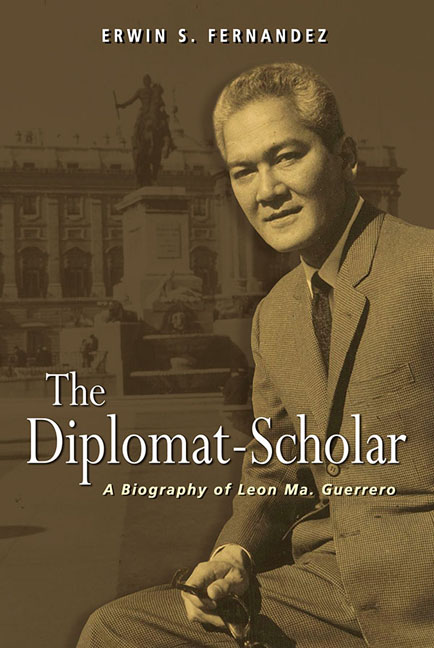Book contents
- Frontmatter
- Dedication
- Contents
- Preface
- Prologue
- Chronology
- I Ermita and Santa Cruz to Intramuros: Between Literary and Legal Career
- II To Tokyo and Back: The Making of a Diplomat
- 5 The Assistant Solicitor
- 6 From Intelligence Officer in Bataan to the Return of Ignacio Javier
- 7 Second, then First Secretary
- 8 At the Home Office: The Diplomat as Historian
- III Going In, then Out of the Political Jungle: Padre Burgos to Arlegui
- IV London and Madrid: The Philippines in a Resurgent Asia
- V New Delhi to Belgrade: The Philippines towards Non-Alignment
- Epilogue
- Glossary
- List of Abbreviations
- Bibliography
- Index
- About the Author
7 - Second, then First Secretary
from II - To Tokyo and Back: The Making of a Diplomat
Published online by Cambridge University Press: 12 January 2018
- Frontmatter
- Dedication
- Contents
- Preface
- Prologue
- Chronology
- I Ermita and Santa Cruz to Intramuros: Between Literary and Legal Career
- II To Tokyo and Back: The Making of a Diplomat
- 5 The Assistant Solicitor
- 6 From Intelligence Officer in Bataan to the Return of Ignacio Javier
- 7 Second, then First Secretary
- 8 At the Home Office: The Diplomat as Historian
- III Going In, then Out of the Political Jungle: Padre Burgos to Arlegui
- IV London and Madrid: The Philippines in a Resurgent Asia
- V New Delhi to Belgrade: The Philippines towards Non-Alignment
- Epilogue
- Glossary
- List of Abbreviations
- Bibliography
- Index
- About the Author
Summary
When the Japanese-sponsored Philippine Republic was inaugurated on 14 October 1943 with Jose P. Laurel as president, Guerrero thought he was no longer a prisoner but a free man, a citizen of an “independent” nation. Resigning from his work in the Hodobu, he waited until December when he was appointed Second Secretary to the Philippine Embassy in Tokyo to be headed by Vargas, now the ambassador whose superior was Minister of Foreign Affairs Claro M. Recto. In the second week of February 1944, leaving behind Annie, he accompanied Vargas, his son and daughter Roberto and Teresita, his private secretary Feniquito, Francisco Lavides the counsellor, and Faustino Sy-Changco, also second secretary, in a trip to Tokyo. At Nielson Airport, President Laurel, Japanese Ambassador to the Philippines Shozo Murata, Speaker Benigno S. Aquino, Chief Justice Jose Yulo, General Shigenori Kuroda and Japanese Navy and Army commanders were there to send them off. Before heading for Haneda Airport in Tokyo, they spent two days and two nights in Formosa (now Taiwan). On 14 February, the party arrived in Tokyo where they met representatives from the Japanese Foreign Office. Their arrival was welcomed in the press because they would complete the five-member nations of the Greater East Asia Co-Prosperity Sphere for greater cooperation among them and Japan. Ambassadors of China, Manchukuo, Thailand, and Burma were in Tokyo ahead of Vargas and his party.
They stayed for two weeks at the Imperial Hotel near the Emperor's Palace because the purchase of a building that would become the chancery of the Philippine Embassy was under negotiation. Guerrero met Leocadio de Asis, one of the ten Filipino police officers sent to study in Japan in one of the latter's visit to the hotel. Purchased at a million pesos, the Yasuda mansion atop the Kudan Hill was not ready for occupation because its heating system was clogged from disuse. The cold of February was intolerable to Vargas so that they stayed in the hotel. By mid-March, the embassy staff left the hotel and moved to the mansion with a wide lawn apt for parties, located at 18-1 Fujimi-cho, 1-chome, Kajomachiku, a walk away from the Japanese Foreign Ministry's office building.
- Type
- Chapter
- Information
- The Diplomat-ScholarA Biography of Leon Ma. Guerrero, pp. 84 - 97Publisher: ISEAS–Yusof Ishak InstitutePrint publication year: 2017

